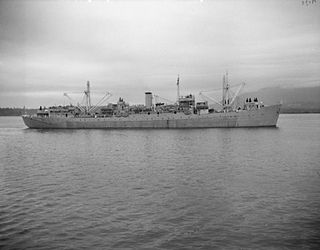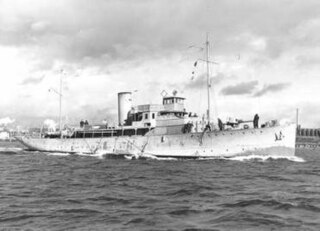Service history
The origin of Laymore is disputed by the sources. Macpherson & Barrie claim the ship was constructed at Kewaunee, Wisconsin while the Miramar Ship Index is unsure as to which ship Laymore was laid down as, believing it could possibly be FS-375 constructed by Sturgeon Bay Shipbuilding and Drydock Company at their yard in Sturgeon Bay, Wisconsin for the United States Army. The ship was transferred to the Royal Canadian Navy during World War II and was commissioned as HMCS Laymore on 12 June 1945. Laymore was stationed on the east coast of Canada and operated in a variety of roles including transporting goods, boom defence and the laying of moorings.
The ship was paid off on 17 April 1946 after the end of the war and transferred to the west coast of Canada in mid-1946. The vessel reentered service as a naval auxiliary and was given the new prefix "CNAV". The conversion to an oceanographic research vessel began on 2 August 1965, with Laymore re-entering service in March 1966 and reclassified with the hull symbol AGOR. In 1977, Laymore was taken out of service and put up for sale. The vessel was purchased by Coast Ferries of Vancouver on 29 March 1977 and converted to a small cargo ship. Renamed Chilcotin Princess, the ship was used to transport cargo and passengers between points on the northern end of Vancouver Island and places around Bella Bella and Bella Coola.Chilcotin Princess was used to transport frozen fish shipments from Namu, British Columbia. In 1987, the vessel underwent minor reconstruction, receiving a new superstructure that could accommodate twelve passengers in six deluxe staterooms, and included a dining room, three lounges and an open sunbridge. In 1998, Chilcotin Princess was sold to the logging industry for use as a helicopter pad.Chilcotin Princess' registry was deleted in 1999 and the vessel was taken to Namu and laid up. The vessel became derelict and on the verge of sinking. The Canadian Coast Guard removed 25,000 litres (5,500 imp gal; 6,600 US gal) of oily water from the vessel, later suing the owner of the vessel for costs incurred.
HMCS Fortune was a Bay-class minesweeper built for the Royal Canadian Navy. Named for Fortune Bay, located in Newfoundland, the vessel served in the Royal Canadian Navy for ten years before being sold for commercial purposes. Renamed MV Edgewater Fortune she saw service as a commercial yacht.

HMCS Cape Breton was a Royal Canadian Navy Cape-class maintenance ship. Originally built for the Royal Navy as HMS Flamborough Head in 1944, she was transferred in 1952. Upon her commissioning she was the second ship to bear the name Cape Breton. She served operationally from 1953–1964, when she was laid up. She was used as a floating machine shop until the late-1990s, before being sold for use as an artificial reef off the coast of British Columbia.

HMCS Newington was a commissioned patrol vessel of the Royal Canadian Navy that served in the First World War. Prior to the war, the ship served as a fishing trawler and lighthouse tender for the Canadian government. Following the war the vessel was returned to government service. Newington was converted to a tugboat in 1920. Sold to private interests in 1920 the ship sank on 26 August 1959 while laid up in Burrard Inlet, British Columbia.
The Cape class consists of two escort maintenance ships of the Royal Canadian Navy (RCN). The ships were built in Canada as Beachy Head-class maintenance ships for the Royal Navy, but were acquired by Canada in 1952. They were commissioned into the RCN in 1959 as HMCS Cape Breton and HMCS Cape Scott. Cape Scott served on the east coast until 1972, after which the ship became a stationary repair vessel at Halifax, Nova Scotia until 1975. The vessel was broken up in 1978. Cape Breton served initially as a school ship on the east coast before transferring to the west coast of Canada in 1959. The maintenance ship remained in service until 1964, when she was laid up at Esquimalt, British Columbia as a maintenance facility. Cape Breton remained in this service until 1993. The vessel was then sold for use as an artificial reef and sunk off the coast of British Columbia.

HMCS Cape Scott was a Cape-class maintenance ship. She was built for the Royal Navy as HMS Beachy Head in 1944. She was loaned to the Royal Netherlands Navy in 1947 as HNLMS Vulkaan and returned to the Royal Navy in 1950. She was sold to the Royal Canadian Navy in 1952 and served until 1975, used as an alongside repair depot after decommissioning.
HMCS Cedarwood was a surveying vessel in the Royal Canadian Navy. She was a wooden sailing ship that was built as MV J.E. Kinney by Smith and Rhuland at Lunenburg, Nova Scotia and used in the harbours of the east coast of Canada by the Royal Canadian Army Service Corps as General Schmidlin during the Second World War. Following the war the vessel was purchased by the Royal Canadian Navy. The ship was sold again for mercantile service in 1959 and remained in service until 1969.

HMCS Saguenay was a St. Laurent-class destroyer that served in the Royal Canadian Navy and later the Canadian Forces from 1956–1990. She was the second vessel in her class and the second Canadian naval unit to carry the name HMCS Saguenay. After being discarded by the Canadian Forces, the ship was sunk as an artificial reef off the coast of Nova Scotia.

HMCS Chignecto was a Bangor-class minesweeper that served in the Royal Canadian Navy during the Second World War. She only saw service on the west coast of Canada during the war. She was named for Chignecto Bay. The vessel's fate is unknown.

HMCS Comox was a Fundy-class minesweeper that served in the Royal Canadian Navy from 1938–1945. She served during the Second World War as a local patrol craft for Esquimalt, British Columbia before transferring to Halifax, Nova Scotia performing general minesweeping duties. After the war she sold for mercantile service and converted to a tugboat named Sung Ming. The ship's registry was deleted in 1993.

HMCS Elk was an armed yacht serving with the Royal Canadian Navy during the Second World War. Prior to Canadian service, the ship was named Arcadia. She was used initially as a patrol vessel, but later saw use as a training and guard ship for submarines on the East Coast of Canada. Following the war, Elk was sold for commercial use and returned to her original name. She was renamed Grand Manan III in 1946 and used as a short-haul passenger ferry before being broken up in 1968.
HMCS Venture was a three-masted schooner built for the Royal Canadian Navy as a training ship in 1937. She served during the Second World War at Halifax, Nova Scotia. She was the second vessel commissioned by the Royal Canadian Navy to bear the name Venture. In 1943, the schooner was renamed Harbour Craft 190. The schooner was sold to private interests following the war and renamed Alfred & Emily before being lost by fire in 1951.
HMCS Moresby was an Anticosti-class minesweeper that served in the Canadian Forces from 1989 to 2000. She was named for Moresby Island, which in turn is named for Fairfax Moresby, former Commander-in-Chief of Pacific Station at Esquimalt Royal Navy Dockyard. Prior to her acquisition by Canada, Moresby served as the offshore supply vessel Joyce Tide, built by Allied Shipbuilders of Vancouver, British Columbia. Joyce Tide was acquired by the Canadian Forces for conversion to a minesweeper and as a training ship for naval reservists. With the entry into service of the Kingston-class coastal defence vessels, Moresby was sold to commercial interests, returning to her previous career. The ship was renamed several times, most recently Ramco Express in 2007.
HMCS Courtenay was a Bangor-class minesweeper constructed for the Royal Canadian Navy during the Second World War. Entering service in 1942, Courtenay spent the entire war on the West Coast of Canada. The vessel was decommissioned in 1945 and sold for mercantile service in 1946. The fate of the vessel is uncertain.
HMCS Malpeque was a Bangor-class minesweeper constructed for the Royal Canadian Navy during the Second World War. Entering service in 1941, the minesweeper took part in the Battle of the Atlantic and the invasion of Normandy. Malpeque was decommissioned in 1945 and placed in reserve. The vessel was reacquired during the Korean War, however the ship never re-entered service and was sold for scrap in 1959.
HMCS Outarde was a Bangor-class minesweeper constructed for the Royal Canadian Navy during the Second World War. Entering service in 1941, the ship spent the entire war on the West Coast of Canada. Following the end of the war, the vessel was sold in 1946 for mercantile conversion and renamed Psing Hsin. In 1950 the vessel was sold again and renamed Content and remained in service until broken up for scrap in 1951.
HMCS Kelowna was a Bangor-class minesweeper constructed for the Royal Canadian Navy during the Second World War. Entering service in 1942, the minesweeper spent the entire war on the West Coast of Canada, mainly as a patrol vessel. Following the war, Kelowna was sold for mercantile conversion. Renamed Hung Hsin and Condor, the final disposition of the vessel is disputed.
The Dun class of tankers comprised two ships, HMCS Dundalk and HMCS Dundurn, constructed for the Royal Canadian Navy during the Second World War. The two vessels were ordered by the Royal Canadian Navy to fill a need to transport fuel oil for convoy escorts in the Battle of the Atlantic. The two vessels began their careers in 1943 and remained in naval service until 1946. Following the end of the war, they were crewed by civilians as naval auxiliaries until the 1980s. Dundalk was wrecked in 1984 and Dundurn's ultimate fate is unknown.

The Llewellyn-class minesweepers were a series of ten coastal minesweepers constructed for the Royal Canadian Navy during the Second World War. Based on the Admiralty type MMS-class minesweeper, the Llewellyn class were constructed of wood and used for the removal of magnetic influence mines. Two were built in Quebec, with the eight constructed on the Western Coast of Canada. Mostly used as guard ships during the war, only three of the ten remained in Royal Canadian Navy service following the war, with the last being discarded in 1957. Following naval service, vessels of the class ended up in commercial service, with some becoming fishing vessels, cargo ships and one a floating restaurant. Six of the ten ships were lost in commercial service.
CNAV Eastore was a coastal auxiliary ship in service with the Royal Canadian Navy during World War II and the Cold War. Eastore, originally constructed as the United States Army Design 381 freighter FS-554, was acquired in 1944 and entered service with the Royal Canadian Navy in December of that year. The ship was paid off on 8 April 1946 and re-entered service as a naval auxiliary (CNAV). The ship remained in service with the Royal Canadian Navy until sold on 30 July 1964.
HMCS Whitethroat was a controlled minelayer based on the Isles-class naval trawler constructed for Canada in the United Kingdom during World War II. The ship was completed near the end of the war and most of its naval service was spent dismantling the defences erected during the war. In 1946 the ship was paid off and became a naval auxiliary and given the new prefix CNAV Whitethroat. As an auxiliary, Whitethroat was used a naval research platform and to repair undersea cables. Reactivated for the Korean War as a minelayer again, the vessel returned to auxiliary service on the Pacific Coast from 1954 to 1967. Whitethroat was sold for scrap in 1967.







